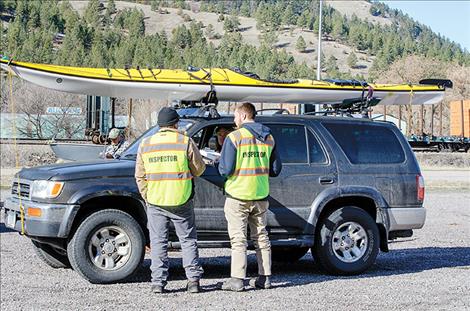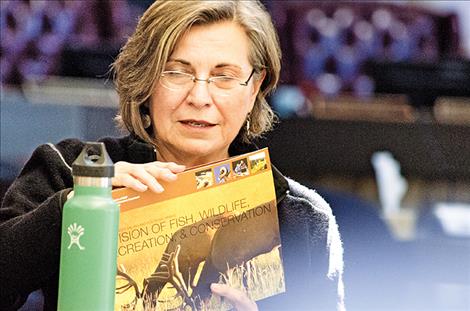Ravalli watercraft check station soon to be open 24/7
Hey savvy news reader! Thanks for choosing local.
You are now reading
1 of 3 free articles.
PABLO – The Flathead Basin Commission recently met to discuss a number of things pertaining to the protection of the quality of the entire Flathead Lake with aquatic invasive species at the forefront of the discussion. The meeting was held on Wednesday, April 25, at the Confederated Salish and Kootenai Tribal Council Chambers.
The FBC was created in 1983 by the Montana Legislature for the purpose of monitoring and protecting water quality and natural resources in what they call one of the state’s most important watersheds. The non-regulatory organization is composed of a board of representatives from different agencies that meet together at different places in the region.
Rich Janssen, CSKT Natural Resources Department head, is the chair for the board. Other members include Glacier National Park representatives, county commissioners within areas around the lake, governor-appointed citizens, conservation district members, Montana Fish, Wildlife and Parks representatives and several others.
The group went through a number of agenda items related to the lake including the future direction of the FBC. Aquatic invasive species have been a big focus in the past few years. Board members talked about shifting the focus to other areas of concern to avoid duplicating the work that organizations and governments are already doing. The issue will be discussed during a future meeting.
Germaine White, CSKT information and education specialist, presented an update to the board about the tribe’s aquatic invasive species program. She said the Montana Fish, Wildlife and Parks and CSKT have a contract to operate a watercraft inspection station in Ravalli to inspect watercraft for invasive aquatic species like zebra and quagga mussels. If those mussels get into the lake they could cover every surface with razor-sharp shells causing massive damage to local habitats, the community, and recreation.
The Ravalli station opened on Friday, March 16, at 7 a.m. and will continue to be open until the fall. CSKT plans to keep the check station open 24 hours a day starting in mid-May for people who go through before or after the 7 a.m. to 7 p.m. hours. She said about 10 percent of watercraft are missed when the station is closed.
She added that the inspection stations are working to help prevent invasive mussels from getting into the lake. When watercraft or boats come in from out-of-state, a hot wash is often done at the station with 140-degree water and hot pressure to remove and kill any adult or microscopic mussels.
“We have inspected approximately 500 watercraft, and approximately 100 inspections were from mussel-fouled states, so they are coming and they are coming early,” she said of the inspections between March and April.
CSKT also conducts a watercraft inspection station at Blue Bay for the Spring Mack Days. More information can be found about inspections station locations at csktnomussels.org.
White said that Tribal conservation officers are working with other law enforcement officials to coordinate on watercraft inspection station drive-bys and any hostile issues that might arise.
“Chief Pablo Espinoza, our conservation officer, has built incredible goodwill with all of the surrounding enforcement, and we are very fortunate to have that,” she said.
She talked about the tribe’s partnership with the Flathead Lake Biological Station along with the Boys and Girls Club and the Flathead Lakers to provide AIS education for middle school students. More than 100 students participated in the 2018 Mussel Walk to educate children with hands-on activities about AIS prevention and detection.
White said the tribe continues to use environmental genetic testing (eDNA) to test water samples to make sure the lake is free of invasive mussels. “EDNA detection occurs earlier and with more frequency so we continue to use that in terms of our monitoring,” she said.
The Tribe’s conservation department is also collaborating with Salish Kootenai College interns and the Bureau of Indian Affairs on an outreach program to educate wakeboard boat users about invasive species.
After listening to the update, the FBC discussed the need to coordinate inspection requirements between all departments and governments so that people know what is required depending on different bodies of water.
Montana FWP representative Jim Williams said one rule was certain: “If you leave the basin, upon coming back and launching again, you must get an inspection. It’s a mandatory requirement.”
He said he thinks overall, people care about protecting the lake and preventing AIS, which, to him, is very important. “These rules only work as well as people are willing to support them,” he said.

















